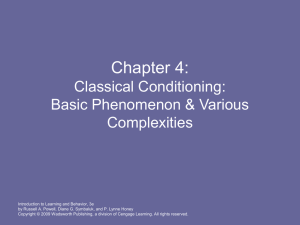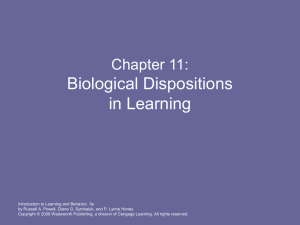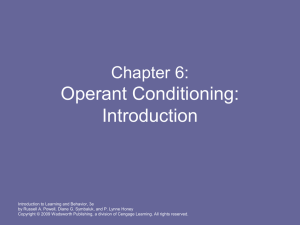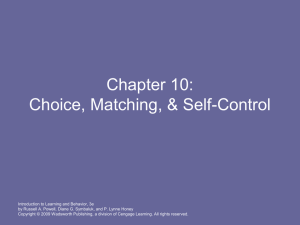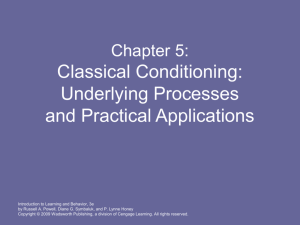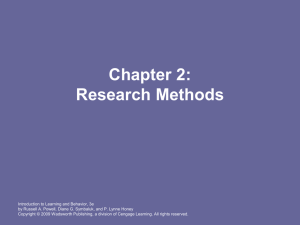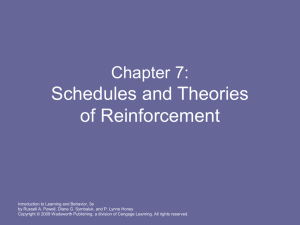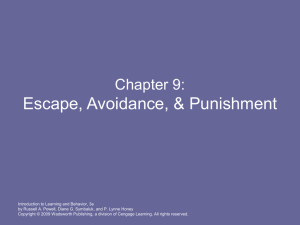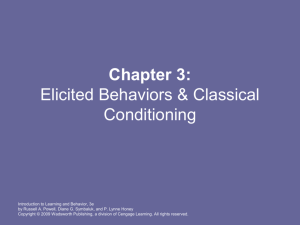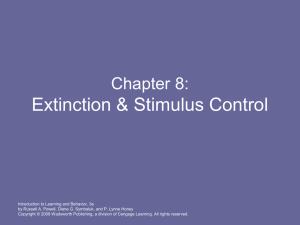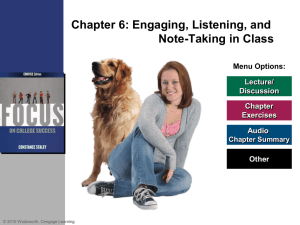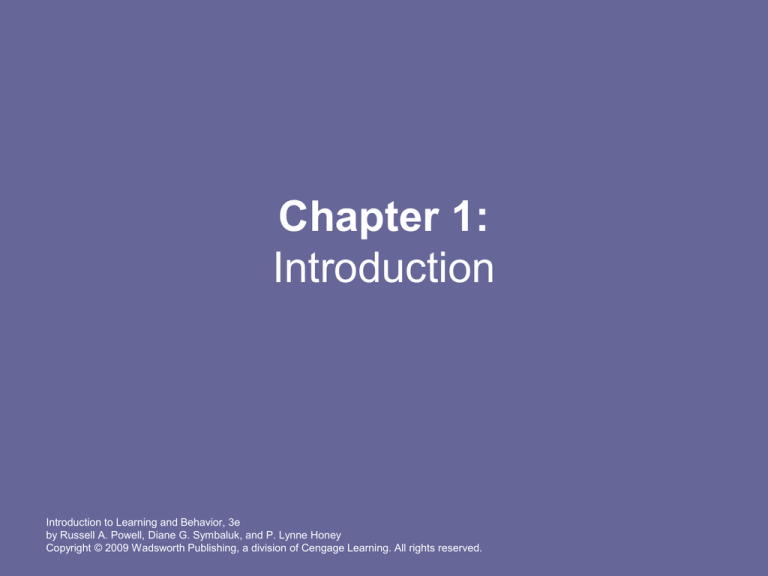
Chapter 1:
Introduction
Introduction to Learning and Behavior, 3e
by Russell A. Powell, Diane G. Symbaluk, and P. Lynne Honey
Copyright © 2009 Wadsworth Publishing, a division of Cengage Learning. All rights reserved.
This text will help us
•
•
•
•
•
•
Improve study habits
Understand eating disorders
Overcome fears and phobias
Improve relationships with others
Raise children
Understand why you behave the way you
do and how your behavior can be changed
for the better…
Introduction to Learning and Behavior, 3e
by Russell A. Powell, Diane G. Symbaluk, and P. Lynne Honey
Copyright © 2009 Wadsworth Publishing, a division of Cengage Learning. All rights reserved.
What is behavior?
• any activity of an organism that can be
observed or somehow measured.
• The activity may be internal or external.
• The activity may or may not be visible to
others.
Introduction to Learning and Behavior, 3e
by Russell A. Powell, Diane G. Symbaluk, and P. Lynne Honey
Copyright © 2009 Wadsworth Publishing, a division of Cengage Learning. All rights reserved.
What is learning?
• a relatively permanent change in behavior that
results from some type of experience.
• The change in behavior does not have to be
immediate – it might not become evident until
long after the experience has occurred.
• Example:
– Reading the textbook is a behavior.
– Changing your behavior as a result is learning.
Introduction to Learning and Behavior, 3e
by Russell A. Powell, Diane G. Symbaluk, and P. Lynne Honey
Copyright © 2009 Wadsworth Publishing, a division of Cengage Learning. All rights reserved.
Classical Conditioning
• the process by which certain inborn behaviors
come to be produced in new situations.
• These behaviors are reflexive or “involuntary”.
• Classical conditioning can help explain many of
our emotional responses and our likes and
dislikes.
• It can explain how we develop debilitating fears
and powerful feelings of sexual attraction.
• Examples:
– sneezing in response to dust
Introduction to Learning and Behavior, 3e
by Russell A. Powell, Diane G. Symbaluk, and P. Lynne Honey
Copyright © 2009 Wadsworth Publishing, a division of Cengage Learning. All rights reserved.
Notations for Classical Conditioning
• Example: a dog learning to salivate in
response to a bell that has been paired
with food
Bell: Food → Salivation
Bell → Salivation
Introduction to Learning and Behavior, 3e
by Russell A. Powell, Diane G. Symbaluk, and P. Lynne Honey
Copyright © 2009 Wadsworth Publishing, a division of Cengage Learning. All rights reserved.
Operant Conditioning
• involves the strengthening or weakening of a
behavior as a result of its consequences.
• These behaviors are “voluntary” or goal directed.
• The consequence of the behavior serves to
strengthen future occurrences of that behavior.
• Examples:
– hit the remote button to turn on a favorite TV show
– study diligently to obtain a passing grade
Introduction to Learning and Behavior, 3e
by Russell A. Powell, Diane G. Symbaluk, and P. Lynne Honey
Copyright © 2009 Wadsworth Publishing, a division of Cengage Learning. All rights reserved.
Notations for Operant Conditioning
• Example: a rat that has learned to press a
lever to obtain food.
Lever press → Food pellet
The effect: Likelihood of lever pressing
increases
Introduction to Learning and Behavior, 3e
by Russell A. Powell, Diane G. Symbaluk, and P. Lynne Honey
Copyright © 2009 Wadsworth Publishing, a division of Cengage Learning. All rights reserved.
Observational Learning
• involves observation of a model’s
behavior, which facilitates the
development of similar behavior in an
observer.
• Example:
– Learning to ski by watching the instructor ski
Introduction to Learning and Behavior, 3e
by Russell A. Powell, Diane G. Symbaluk, and P. Lynne Honey
Copyright © 2009 Wadsworth Publishing, a division of Cengage Learning. All rights reserved.
Historical Background
Introduction to Learning and Behavior, 3e
by Russell A. Powell, Diane G. Symbaluk, and P. Lynne Honey
Copyright © 2009 Wadsworth Publishing, a division of Cengage Learning. All rights reserved.
Nativist (Nature)
• assumes that a person’s abilities and
behavioral tendencies are largely inborn.
• Plato believed that everything we know is
inborn.
• Learning is simply a process of inner
reflection to uncover the knowledge that
already exists within.
Introduction to Learning and Behavior, 3e
by Russell A. Powell, Diane G. Symbaluk, and P. Lynne Honey
Copyright © 2009 Wadsworth Publishing, a division of Cengage Learning. All rights reserved.
Empiricist (Nurture)
• assumes that a person’s abilities and
tendencies are mostly learned.
• Aristotle disagreed with Plato.
• He argued that knowledge is not inborn
but instead is acquired through
experience.
Introduction to Learning and Behavior, 3e
by Russell A. Powell, Diane G. Symbaluk, and P. Lynne Honey
Copyright © 2009 Wadsworth Publishing, a division of Cengage Learning. All rights reserved.
Aristotle’s Four Laws of Association
•
•
•
•
The Law of Similarity.
The Law of Contrast.
The Law of Contiguity.
The Law of Frequency.
The laws of contiguity and frequency are still
considered important aspects of learning.
Introduction to Learning and Behavior, 3e
by Russell A. Powell, Diane G. Symbaluk, and P. Lynne Honey
Copyright © 2009 Wadsworth Publishing, a division of Cengage Learning. All rights reserved.
Mind–Body Dualism
• Descartes’ notion that some human
behaviors are reflexes that are
automatically elicited by external
stimulation, while other behaviors are
freely chosen and controlled by the mind.
• Thus suggesting that at least some
behaviors—namely, reflexive behaviors—
are mechanistic and could therefore be
scientifically investigated.
Introduction to Learning and Behavior, 3e
by Russell A. Powell, Diane G. Symbaluk, and P. Lynne Honey
Copyright © 2009 Wadsworth Publishing, a division of Cengage Learning. All rights reserved.
The British Empiricists
• believed almost all knowledge is a function
of experience.
• John Locke proposed that a newborn’s
mind is a blank slate upon which
environmental experiences are written.
Introduction to Learning and Behavior, 3e
by Russell A. Powell, Diane G. Symbaluk, and P. Lynne Honey
Copyright © 2009 Wadsworth Publishing, a division of Cengage Learning. All rights reserved.
Structuralism
• holds that it is possible to determine the
structure of the mind by identifying the basic
elements that compose it.
• The method of introspection is when the subject
in an experiment attempts to accurately describe
his or her conscious thoughts, emotions, and
sensory experiences.
• The emphasis on systematic observation helped
establish psychology as a scientific discipline.
Introduction to Learning and Behavior, 3e
by Russell A. Powell, Diane G. Symbaluk, and P. Lynne Honey
Copyright © 2009 Wadsworth Publishing, a division of Cengage Learning. All rights reserved.
Functionalism
• assumes that the mind evolved to help us adapt
to the world around us and that the focus of
psychology should be the study of those
adaptive processes.
• Psychologists should study the adaptive
significance of the mind.
• E. B. Thorndike and John B. Watson, two of the
most important figures in behaviorism, were
students of functionalist psychologists.
Introduction to Learning and Behavior, 3e
by Russell A. Powell, Diane G. Symbaluk, and P. Lynne Honey
Copyright © 2009 Wadsworth Publishing, a division of Cengage Learning. All rights reserved.
Theory of Evolution
• Natural selection is the concept that
individuals or species that are capable of
adapting to environmental pressures are
more likely to survive and reproduce than
those that cannot adapt.
– Traits vary,
– many traits are heritable, and
– organisms must compete for limited resources.
Introduction to Learning and Behavior, 3e
by Russell A. Powell, Diane G. Symbaluk, and P. Lynne Honey
Copyright © 2009 Wadsworth Publishing, a division of Cengage Learning. All rights reserved.
The real driving force behind
evolution is not survival of the
fittest…
but the reproductive advantage that accrues
to those individuals possessing traits that
are best suited to the environment.
Introduction to Learning and Behavior, 3e
by Russell A. Powell, Diane G. Symbaluk, and P. Lynne Honey
Copyright © 2009 Wadsworth Publishing, a division of Cengage Learning. All rights reserved.
Evolutionary Adaptation
• a trait that evolves as a result of natural
selection
• Individuals with successful traits are more
likely to have offspring who, when they
inherit the successful traits from their
parents, are also more likely to survive
and reproduce.
• These traits can be both physical
adaptations & behaviors.
Introduction to Learning and Behavior, 3e
by Russell A. Powell, Diane G. Symbaluk, and P. Lynne Honey
Copyright © 2009 Wadsworth Publishing, a division of Cengage Learning. All rights reserved.
The Ability to Learn
• evolved because it conferred significant
survival advantages to those who had this
ability.
Introduction to Learning and Behavior, 3e
by Russell A. Powell, Diane G. Symbaluk, and P. Lynne Honey
Copyright © 2009 Wadsworth Publishing, a division of Cengage Learning. All rights reserved.
Behaviorism
• the study of environmental influences on
observable behavior.
• We are unable to directly observe another
person’s thoughts and feelings.
• Watson reasoned that for psychology to be
a purely “objective science”, it must be
based solely on the study of directly
observable behavior and the
environmental events that surround it.
Introduction to Learning and Behavior, 3e
by Russell A. Powell, Diane G. Symbaluk, and P. Lynne Honey
Copyright © 2009 Wadsworth Publishing, a division of Cengage Learning. All rights reserved.
Law of Parsimony
• simpler explanations for a phenomenon are
generally preferable to more complex
explanations.
• Morgan’s Canon argued that we should interpret
an animal’s behavior in terms of
– lower, more primitive processes (e.g., reflex or habit)
– rather than higher, more mentalistic processes (e.g.,
decision or imagination).
• Watson thought the same should be true for
interpretations of human behavior.
Introduction to Learning and Behavior, 3e
by Russell A. Powell, Diane G. Symbaluk, and P. Lynne Honey
Copyright © 2009 Wadsworth Publishing, a division of Cengage Learning. All rights reserved.
Five Schools of Behaviorism
Introduction to Learning and Behavior, 3e
by Russell A. Powell, Diane G. Symbaluk, and P. Lynne Honey
Copyright © 2009 Wadsworth Publishing, a division of Cengage Learning. All rights reserved.
Watson’s Methodological
Behaviorism
• Psychologists should study only publicly
observable behavior.
• Events that can only be
– subjectively perceived (such as our inner thoughts
and feelings)
– or that are assumed to exist on an unconscious level
(such as a mother’s unconscious hatred of her
unwanted child)
were to be stricken from scientific analysis.
• Few behaviorists were this extreme.
Introduction to Learning and Behavior, 3e
by Russell A. Powell, Diane G. Symbaluk, and P. Lynne Honey
Copyright © 2009 Wadsworth Publishing, a division of Cengage Learning. All rights reserved.
Methodological Behaviorism
Introduction to Learning and Behavior, 3e
by Russell A. Powell, Diane G. Symbaluk, and P. Lynne Honey
Copyright © 2009 Wadsworth Publishing, a division of Cengage Learning. All rights reserved.
Hull’s Neobehaviorism
• Hull claimed that Watson’s rejection of unobservable
events was scientifically unsound.
• Hull noted that both physicists and chemists make
inferences about events that have never been directly
observed but that can nevertheless be operationalized.
• Psychologists should infer the existence of internal
events that might mediate between the environment and
behavior.
• Mediators largely consisted of physiological-type
reactions.
• Example: a “hunger drive” that can be operationalized as
number of hours of food deprivation.
Introduction to Learning and Behavior, 3e
by Russell A. Powell, Diane G. Symbaluk, and P. Lynne Honey
Copyright © 2009 Wadsworth Publishing, a division of Cengage Learning. All rights reserved.
Neobehaviorism
Introduction to Learning and Behavior, 3e
by Russell A. Powell, Diane G. Symbaluk, and P. Lynne Honey
Copyright © 2009 Wadsworth Publishing, a division of Cengage Learning. All rights reserved.
Tolman’s Cognitive Behaviorism
• Tolman disagreed with Hull and believed that it would be
more useful to analyze behavior on a broader level.
• Behavior is more than just a chain of discrete responses
attached to discrete stimuli.
• It is an overall pattern of behavior directed toward
particular outcomes.
• Tolman’s cognitive behaviorism utilizes intervening
variables, usually in the form of hypothesized cognitive
processes, to help explain behavior.
• We create cognitive maps which are mental
representations of our spatial surroundings.
Introduction to Learning and Behavior, 3e
by Russell A. Powell, Diane G. Symbaluk, and P. Lynne Honey
Copyright © 2009 Wadsworth Publishing, a division of Cengage Learning. All rights reserved.
Cognitive Behaviorism
Introduction to Learning and Behavior, 3e
by Russell A. Powell, Diane G. Symbaluk, and P. Lynne Honey
Copyright © 2009 Wadsworth Publishing, a division of Cengage Learning. All rights reserved.
Bandura’s Social Learning Theory
• a cognitive-behavioral approach that strongly
emphasizes the importance of observational learning
and cognitive variables in explaining human behavior
• Reciprocal determinism states that environmental
events, observable behavior, and “person variables”
(including thoughts and feelings) have a reciprocal
influence on each other.
• Social Learning Theory has stimulated the development
of cognitive-behavior therapy, in which psychological
disorders are treated by altering both environmental
variables and cognitive processes.
Introduction to Learning and Behavior, 3e
by Russell A. Powell, Diane G. Symbaluk, and P. Lynne Honey
Copyright © 2009 Wadsworth Publishing, a division of Cengage Learning. All rights reserved.
Social Learning Theory
Introduction to Learning and Behavior, 3e
by Russell A. Powell, Diane G. Symbaluk, and P. Lynne Honey
Copyright © 2009 Wadsworth Publishing, a division of Cengage Learning. All rights reserved.
Skinner’s Radical Behaviorism
• emphasizes the influence of the environment on overt
behavior, rejects the use of internal events to explain
behavior, and views thoughts and feelings as behaviors
that themselves need to be explained.
• Internal events, such as sensing, thinking, and feeling,
as “covert” or private behaviors that are subject to the
same laws of learning as “overt” or publicly observable
behaviors.
• Example:
– studying and any thoughts about achieving a high mark by
studying are the result of some experience, such as a history of
doing well on exams when the student did study
Introduction to Learning and Behavior, 3e
by Russell A. Powell, Diane G. Symbaluk, and P. Lynne Honey
Copyright © 2009 Wadsworth Publishing, a division of Cengage Learning. All rights reserved.
Radical Behaviorism
Introduction to Learning and Behavior, 3e
by Russell A. Powell, Diane G. Symbaluk, and P. Lynne Honey
Copyright © 2009 Wadsworth Publishing, a division of Cengage Learning. All rights reserved.
Why not study internal events?
• Our assessments of internal thoughts and feelings thus
are often unreliable.
– Example: the task of teaching a young boy to correctly label the
feeling of pain.
• It is often difficult to determine the actual relationship of
thoughts and feelings to behavior.
– Example: the act of providing help in an emergency.
• We do not have any means of directly changing these
internal events.
• Such explanations are sometimes only pseudo
explanations.
– Example, I “feel like going to the movies.”
Introduction to Learning and Behavior, 3e
by Russell A. Powell, Diane G. Symbaluk, and P. Lynne Honey
Copyright © 2009 Wadsworth Publishing, a division of Cengage Learning. All rights reserved.
Skinner’s Molar View
• Only reflexive behaviors are automatically
elicited by the stimuli that precede them.
– Example: salivating in response to food
• Reflexive behaviors are distinguished from
behaviors that are controlled by their
consequences, which are more flexible and less
predictable.
– Example: rat is running through the maze because
such behavior has in the past resulted in food.
• We should explain the behavior by referring to
past experience.
Introduction to Learning and Behavior, 3e
by Russell A. Powell, Diane G. Symbaluk, and P. Lynne Honey
Copyright © 2009 Wadsworth Publishing, a division of Cengage Learning. All rights reserved.
Skinner’s View of Genetic Factors
• Behavior is fundamentally the result of the interaction
between genes and the environment.
• However, genetic factors are largely unmodifiable.
• To assume that a behavior pattern has a strong genetic
basis is to assume also that little can be done to alter it.
• Skinner believed that genes have a great impact on
behavior but behaviors can change.
• Behaviors that lead to favorable outcomes are more
likely to be repeated, whereas those that do not lead to
favorable outcomes are less likely to be repeated.
Introduction to Learning and Behavior, 3e
by Russell A. Powell, Diane G. Symbaluk, and P. Lynne Honey
Copyright © 2009 Wadsworth Publishing, a division of Cengage Learning. All rights reserved.
Behavior Analysis
• grew out of radical behaviorism.
• Applied Behavior Analysis is a technology
of behavior in which basic principles of
behavior are applied to real-world issues.
– also sometimes referred to as behavior
modification
– Example: helping people with clinical
disorders, such as phobias and schizophrenia
Introduction to Learning and Behavior, 3e
by Russell A. Powell, Diane G. Symbaluk, and P. Lynne Honey
Copyright © 2009 Wadsworth Publishing, a division of Cengage Learning. All rights reserved.
Summary
This text will introduce us to:
• Classical Conditioning, in which reflexive
behaviors come to be elicited in new
situations
• Operant Conditioning, in which the
probability of a behavior is influenced by
its consequences
Introduction to Learning and Behavior, 3e
by Russell A. Powell, Diane G. Symbaluk, and P. Lynne Honey
Copyright © 2009 Wadsworth Publishing, a division of Cengage Learning. All rights reserved.
Summary of Historical Significance
• Aristotle assumed that knowledge is largely gained from
experience
• Descartes proposed that involuntary behaviors are
automatically elicited by external stimulation
• British empiricists argued that all knowledge is a function
of experience
• Structuralists hold that we need to identify the basic
elements that compose it
• Darwin’s theory of evolution says that adaptive
characteristics evolve through the process of natural
selection.
• Functionalists study publicly observable behavior and
the environmental events that influence them
Introduction to Learning and Behavior, 3e
by Russell A. Powell, Diane G. Symbaluk, and P. Lynne Honey
Copyright © 2009 Wadsworth Publishing, a division of Cengage Learning. All rights reserved.
Summary of Schools of
Behaviorism
•
•
•
•
•
Watson’s methodological behaviorism
Hull’s neobehaviorism
Tolman’s cognitive behaviorism
Bandura’s social learning theory
Skinner’s radical behaviorism
Introduction to Learning and Behavior, 3e
by Russell A. Powell, Diane G. Symbaluk, and P. Lynne Honey
Copyright © 2009 Wadsworth Publishing, a division of Cengage Learning. All rights reserved.

